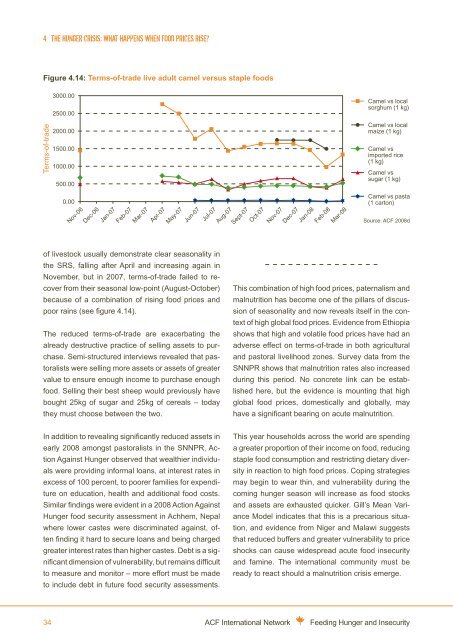Feeding hunger and insecurity
Feeding hunger and insecurity
Feeding hunger and insecurity
- No tags were found...
Create successful ePaper yourself
Turn your PDF publications into a flip-book with our unique Google optimized e-Paper software.
4. the <strong>hunger</strong> crisis: what happens when food prices rise?Figure 4.14: Terms-of-trade live adult camel versus staple foods3000.002500.00Camel vs localsorghum (1 kg)Terms-of-trade2000.001500.001000.00500.00Camel vs localmaize (1 kg)Camel vsimported rice(1 kg)Camel vssugar (1 kg)0.00Nov-06Dec-06Jan-07Feb-07Mar-07Apr-07May-07Jun-07Jul-07Aug-07Sept-07Oct-07Nov-07Dec-07Jan-08Feb-08Mar-08Camel vs pasta(1 carton)Source: ACF 2008dof livestock usually demonstrate clear seasonality inthe SRS, falling after April <strong>and</strong> increasing again inNovember, but in 2007, terms-of-trade failed to recoverfrom their seasonal low-point (August-October)because of a combination of rising food prices <strong>and</strong>poor rains (see figure 4.14).The reduced terms-of-trade are exacerbating thealready destructive practice of selling assets to purchase.Semi-structured interviews revealed that pastoralistswere selling more assets or assets of greatervalue to ensure enough income to purchase enoughfood. Selling their best sheep would previously havebought 25kg of sugar <strong>and</strong> 25kg of cereals – todaythey must choose between the two.This combination of high food prices, paternalism <strong>and</strong>malnutrition has become one of the pillars of discussionof seasonality <strong>and</strong> now reveals itself in the contextof high global food prices. Evidence from Ethiopiashows that high <strong>and</strong> volatile food prices have had anadverse effect on terms-of-trade in both agricultural<strong>and</strong> pastoral livelihood zones. Survey data from theSNNPR shows that malnutrition rates also increasedduring this period. No concrete link can be establishedhere, but the evidence is mounting that highglobal food prices, domestically <strong>and</strong> globally, mayhave a significant bearing on acute malnutrition.In addition to revealing significantly reduced assets inearly 2008 amongst pastoralists in the SNNPR, ActionAgainst Hunger observed that wealthier individualswere providing informal loans, at interest rates inexcess of 100 percent, to poorer families for expenditureon education, health <strong>and</strong> additional food costs.Similar findings were evident in a 2008 Action AgainstHunger food security assessment in Achhem, Nepalwhere lower castes were discriminated against, oftenfinding it hard to secure loans <strong>and</strong> being chargedgreater interest rates than higher castes. Debt is a significantdimension of vulnerability, but remains difficultto measure <strong>and</strong> monitor – more effort must be madeto include debt in future food security assessments.This year households across the world are spendinga greater proportion of their income on food, reducingstaple food consumption <strong>and</strong> restricting dietary diversityin reaction to high food prices. Coping strategiesmay begin to wear thin, <strong>and</strong> vulnerability during thecoming <strong>hunger</strong> season will increase as food stocks<strong>and</strong> assets are exhausted quicker. Gill’s Mean VarianceModel indicates that this is a precarious situation,<strong>and</strong> evidence from Niger <strong>and</strong> Malawi suggeststhat reduced buffers <strong>and</strong> greater vulnerability to priceshocks can cause widespread acute food <strong>insecurity</strong><strong>and</strong> famine. The international community must beready to react should a malnutrition crisis emerge.34ACF International Network<strong>Feeding</strong> Hunger <strong>and</strong> Insecurity

















